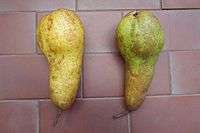1-Methylcyclopropene
| |||
 | |||
| Names | |||
|---|---|---|---|
| IUPAC name
1-Methylcyclopropene | |||
| Identifiers | |||
| 3100-04-7 | |||
| 3D model (Jmol) | Interactive image | ||
| Abbreviations | 1-MCP | ||
| ChEBI | CHEBI:132592 | ||
| ChemSpider | 133162 | ||
| ECHA InfoCard | 100.130.871 | ||
| PubChem | 151080 | ||
| UNII | J6UJO23JGU | ||
| |||
| |||
| Properties | |||
| C4H6 | |||
| Molar mass | 54.09 g/mol | ||
| Boiling point | ~12 °C[1] | ||
| Except where otherwise noted, data are given for materials in their standard state (at 25 °C [77 °F], 100 kPa). | |||
| | |||
| Infobox references | |||
1-Methylcyclopropene (1-MCP) is a cyclopropene derivative used as a synthetic plant growth regulator. It is structurally related to the natural plant hormone ethylene and it is used commercially to slow down the ripening of fruit and to help maintain the freshness of cut flowers.[2]
Chemical properties
1-MCP is a cycloalkene with the molecular formula C4H6. It is a volatile gas at standard temperature and pressure with a boiling point of ~12 °C.
Methylcyclopropene can refer to either of two isomers, 1-methylcyclopropene covered in this article, or 3-methylcyclopropene[3] which is not covered in this article. 2-methylcyclopropene would be an incorrect name for 1-methylcyclopropene. Also note: methylcyclopropane is yet a different chemical compound, which is a cycloalkane with the formula C4H8.
Mechanism of action
Ethylene exists as a gas and it acts at trace levels throughout the life of a plant by stimulating or regulating various processes such as the ripening of climacteric fruit, the opening of flowers, and the shedding of leaves.[4][5] The mechanism of action of 1-MCP involves its tightly binding to the ethylene receptor in plants, thereby blocking the effects of ethylene (competitive inhibitor).[6][7]
Commercial use

There are two principal commercial uses of 1-MCP: maintaining the freshness of ornamental plants and flowers, and preventing the ripening of fruits. In each case, 1-MCP is combined with other materials for handling and then mixed with a specific amount of water or other solution to release it into the air.[8] It is used in enclosed indoor sites, such as coolers, truck trailers, greenhouses, storage facilities, and shipping containers.[8]
Under the brand name EthylBloc, 1-MCP was approved by the U.S. Environmental Protection Agency for use on ornamental crops.[9] It is used with cut flowers, potted flowers, and bedding, nursery and foliage plants to prevent premature wilting, leaf yellowing, premature opening, and premature death.[10][11]
Under the brand name SmartFresh, 1-MCP is used in the agriculture industry by growers, packers, and shippers to maintain the quality of fruits and vegetables by preventing or delaying the natural ripening process. The use of 1-MCP in agricultural products including apples, kiwifruit, tomatoes, bananas, plums, persimmons, avocados and melons has been approved and accepted for use in more than 34 countries including the European Union and the United States.[12] Although there are benefits to the consumer, including fresher produce and lower cost, there is some concern that consumers may be purchasing fruit that is older than expected, with less vitamins.[13]
1-MCP is also being developed as a new crop protection technique. By spraying 1-MCP on growing field crops during times of stress, the crops may be protected from moderate heat and drought conditions.[14]
References
- ↑ Synthesis Methods, Complexes and Delivery Methods for the Safe and Convenient Storage, Transport and Application of Compounds for Inhibiting the Ethylene Response in Plants, US Patent 6,017,849, James Daly and Bob Kourelis, January 25, 2000.
- ↑ Blankenship, Sylvia M; Dole, John M (April 2003). "1-Methylcyclopropene: a review". Postharvest Biology and Technology. 28 (1): 1–25. doi:10.1016/S0925-5214(02)00246-6.
- ↑ Chem->Sink 3-methylcyclopropene
- ↑ Chow B, McCourt P (2006). "Plant hormone receptors: perception is everything.". Genes Dev. 20 (15): 1998–2008. doi:10.1101/gad.1432806. PMID 16882977.
- ↑ De Paepe A, Van der Straeten D (2005). "Ethylene biosynthesis and signaling: an overview". Vitam Horm. Vitamins & Hormones. 72: 399–430. doi:10.1016/S0083-6729(05)72011-2. ISBN 978-0-12-709872-2. PMID 16492477.
- ↑ Serek, M.; Tamari, G.; Sisler, E.C.; Borochov, A. (1995). "Inhibition of ethylene-induced cellular senescence symptoms by 1-methylcyclopropene, a new inhibitor of ethylene action". Physiol. Plant. 94 (2): 229–232. doi:10.1111/j.1399-3054.1995.tb05305.x.
- ↑ Sisler E.C., Serek M. (2003). "Compounds interacting with the ethylene receptor in plants". Plant Biol. 5 (5): 473–80. doi:10.1055/s-2003-44782.
- 1 2 1-Methylcyclopropene Fact Sheet, U.S. Environmental Protection Agency
- ↑ Jim Daly; Anne Schluter (2001). "EthylBloc — An Industry Perspective" (PDF). Perishables Handling Quarterly (108): 5.
- ↑ What is EthylBloc technology?, at agrofresh.com
- ↑ EthylBloc Ethylene Inhibitor, at floralife.com
- ↑ SmartFresh Quality System at agrofresh.com
- ↑ Europeans buying year-old apples, by Leah Vyse, December 13, 2005.
- ↑ Syngenta-Agrofresh Alliance: New crop protection technology takes aim at row crops, Farm Industry News, Jan 18, 2008
| Wikimedia Commons has media related to 1-methylcyclopropene. |
